Australian Terrier Dog
A Lovable Little Rascal!
The Australian Terrier dog was bred in the 19th century by selective crossing of terriers from England and Scotland. Some of the stock included the Yorkshire, Skye, Dandie Dinmont, Irish and Cairn terriers.
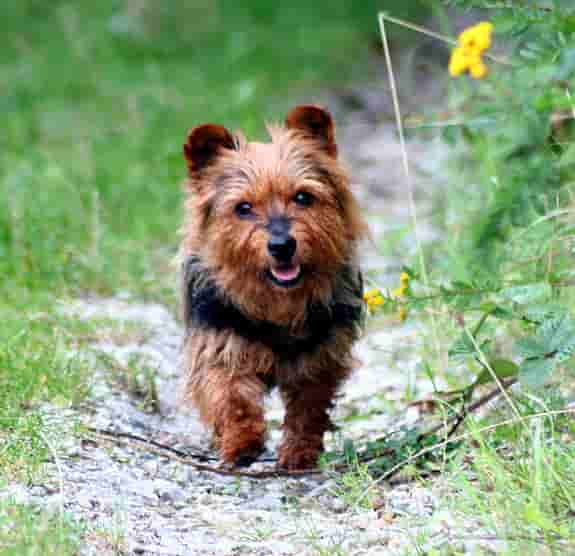 Courtesy Ketterechts
Courtesy KetterechtsThis breed was originally named the Rough Coated Terrier and nowadays is sometimes just called an "Aussie".
He is one of the smallest working terriers and was developed by early Australian settlers who needed an energetic and hardy dog to protect the homesteads and help control the rats and snakes.
This sturdy little package evidently did the job well in a challenging environment.
Subsequently, the Aussie became popularized outside of Australia and was recognized by the English Kennel Club in 1933, followed by the AKC in 1960.
Personality and Traits
Australian Terrier dogs are feisty, loyal, affectionate and intelligent. They have a willingness to please and are
considered by many to be excellent family pets. They have a very lovable demeanor and a rascally face to
go with it.
Leadership should be established and training should be consistent, as like most terriers,
they have an independent streak and will happily make up the rules.
This is not a breed to be exercised off leash as they have strong chasing instincts. They are also known to
have a fondness for digging, so plan your landscaping with this in mind!
Unlike many small dogs, the Aussie has a big dog bark. This feature, along with a confident demeanor and protective
instincts, makes him a good watchdog.
However, too much vocalization might not be appreciated by your neighbors so try teaching him the "quiet command" to keep the peace with those in close proximity!
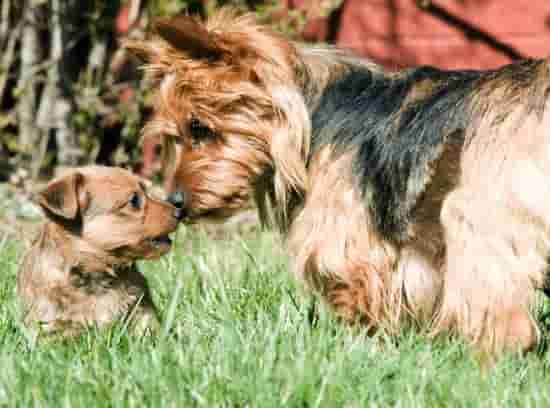 Australian Terrier With Puppy
Australian Terrier With PuppyAppearance, Coat and Care
ight: 10-11 inches
Weight: 12-14 lbs.
Color variations: Blue/tan, Sand or Red.
The Aussie is a low set little dog wearing a shaggy double coat with silky topknot, and bearing a devilishly sweet and lively expression. In my view, he bears a strong resemblance to the Cairn.
The coat is dense and harsh in texture which sheds little. This means that the dead hair needs to be removed by a thorough brushing approximately every other day.
However, certain areas of the coat grow quickly especially around the
eyes, in the ears and between the foot pads and should be inspected for debris or parasites and kept trimmed.
Additionally, the coat should be hand stripped about every three
months to allow for new growth.
Hand stripping keeps the coat in its natural state and texture, preserving the Aussie's charming appearance!
Health Profile of the Australian Terrier Dog
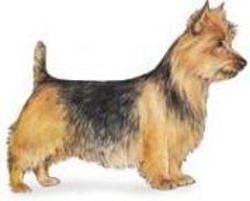
The Australian Terrier has an overall reputation for being pretty rugged and with good nutrition and care, can be expected to enjoy a lifespan of up to 14 years. Obviously, like all dogs, there are some diseases that may affect him at some point.
Health issues associated with the breed include these inherited conditions:
- Slipping kneecap (aka Luxating Patella)
- Legg-Calve-Perthes Disease - causing the ball of the femur to degenerate in one or both hips and subsequently lead to arthritis
- Hip Dysplasia - malformation of the hip ball and socket leading to degenerative joint disease and hip arthritis
- Elbow Dysplasia - elbow arthritis caused by abnormal elbow-joint growth
Other diseases to which they are predisposed include:
- Cancer
- Ear infections
- Cataracts
Activity Level and Ideal Living Space
The Australian Terrier, much like most terriers, are very active little dogs and should be taken out for regular
walks.
The Aussie breed is quite adaptable and can do well in apartment or house, but obviously enjoys the great outdoors as well.
They like to practice their digging skills, chase any fast moving critters and generally romp around outside, so they'd be grateful for some space to do this!
But, be forewarned, they are great escape artists so keep fences very secure, no loose boards or escape routes to dig under, and gates locked.
The Aussie and Children?
Australian Terrier dogs are affectionate with their family and have a reputation for being very good companions for children. But, they are tough little dogs that won't suffer being teased or mishandled. They also can be possessive of their toys and food.
For these reasons, they do best with older children who are respectful and kind with pets.
As always, no matter what the breed, interaction between children and dogs should be supervised by an adult.
Seniors Or Less Active Families?
A good companion and an excellent watchdog for any family - seniors or the more sedentary - providing daily exercise can be arranged.
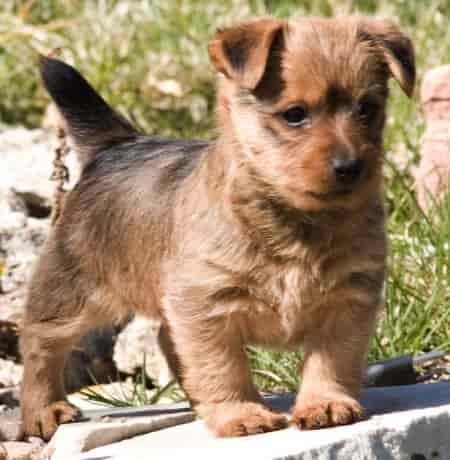
Tell Us About Your Australian Terrier
Are you the proud owner of an Australian Terrier dog? Would your dog like his own web page on this site where you
can talk about him and how great he is and share his pictures with others?
We love dog stories and pics, so we've made it quick and easy for you to brag about dog with us and our visitors.
You're invited to go here and get started.
Can't wait to have your dog join our community!
Before You Go...
If you like the content of this page, as well as others on my site, please give it some love by clicking on the heart in the lower right hand corner. This helps me keep providing enjoyable and useful content.
Thank you.
Further Reading
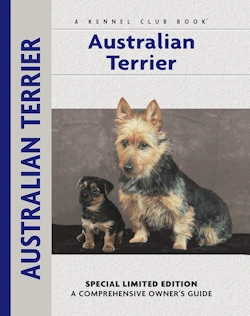
Australian Terrier: A Comprehensive Owner's Guide
Covers breed history, characteristics, puppy selection, feeding, training, health care and behavior.
Also includes advice about preparing for the puppy, house-training and potential puppy problems. Over 135
color photos.
Interested in the Australian Terrier dog breed? If you are, a rescue is a great way to acquire one.
Check out the Aussie rescue organization for more information..

Cropped Images: Ketterechts License
Flickr Larry Jacobsen License